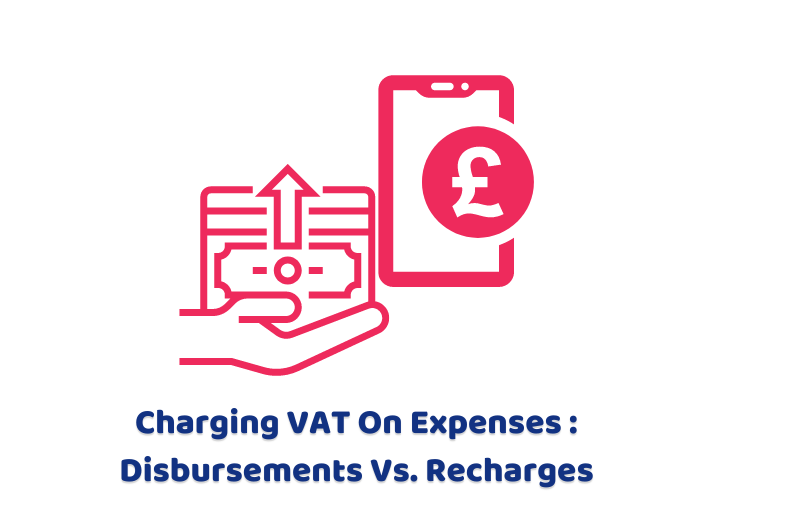Charging VAT on disbursements and on recharges brings a lot of confusion along with them due to the perplexing nature of VAT. Many people who deliver VATable products and services have to pay VAT on them while reclaiming them later from HMRC if these are part of their business expense.
However, there are certain VATable services and products not consumed and used by the business, but the clients use them. So, the question of calculation of VAT arises.
In this blog, we will walk you through the disbursements and recharges and the difference between them. Moreover, we will discuss when and how you should calculate VAT. So, let’s start our discussion!
Disbursements and recharges are tricky for many, especially when you calculate VAT on them. Worry not!!! Get instant and professional help from qualified accountants at AccountingFirms now.
What is a Disbursement?
A disbursement is a payment or a type of business expense that a business makes on the behalf of its customer. There are certain services and products a client will use later but the business buys them on behalf of the customer, as it is part of their contract.
However, the client agrees to pay for the purchase a business has made. Now, the question arises how the VAT on disbursements will be calculated.
The answer to this question lies in the role of the business. As the business itself is not buying and consuming the product or services. The contractor is only buying the goods as an intermediary or the agent between the supplier and the client. So, he won’t pay VAT on it. Only client is responsible for it.
To treat a Payment as a disbursement all of the following must apply:
- It was your customer’s responsibility to pay for the goods or services, not yours.
- The goods and services you paid for are in addition to the cost of your own services.
- You had permission from your customer to make the payment.
- You paid the supplier on your customer’s behalf and acted as the agent of your customer.
- You pass on the exact amount of each cost to your customer when you invoice them.
- You show the costs separately on your invoice.
- Your customer knew that the goods or services were from another supplier, not from you.
- Your customer received, used or had the benefit of the goods or services you paid for on their behalf.
What is a Recharge?
A recharge is a type of business expense a business has to incur to complete a business activity. For example, a contractor might have to stay in a hotel as a part of their business to attend a trade show or any business meeting in another city. Moreover, they have to incur the travel costs as well.
All of these costs are counted as the recharges and these business expenses are purely business in nature and have been consumed by the business alone.
So, the organisation will be responsible to pay VAT on them. These VATs on standard rated and reduced rated products and services can be reclaimed from HMRC.
However, there’s no need to add VAT on the zero-rated goods and services like Railway tickets and postage services. If you have paid VAT on recharges, you can reclaim them as business expenses.
Difference Between Disbursements and Recharges
Let’s understand the difference between a disbursement and a recharge with the help of an example. Before that, you need to understand that when you pass on costs to your customer you are acting as an agent.
For example, John is providing websites and designing services to a client. For his services, he’s charging £2,000. For this, he needs to visit the client for the project discussion and he incurs a travelling cost of £300. Moreover, he will purchase a hosting plan on the client’s behalf as it will be consumed by the client himself later.
The final VAT invoice of John will look like this:
Web development and designing services: £2, 000
Travelling Expenses: £300
VATable amount = £2, 300
VAT = 20% of £2, 300 = £460
Hosting Plan: £200
Total Cost + VAT = £2, 960
In other words, the Travelling expenses are a part of the primary services, so they are recharges and VATable. On the other hand, the hosting plan will be used by the client. So, it is a disbursement. The contractor won’t pay VAT on it.
The Bottom Line
Wrapping up the discussion, we conclude that VAT on disbursements and recharges are easier to calculate if you take care of the nature of the products as standard rated or zero rated.
On the other hand, the costs passed on to clients as disbursements does not require you to add VAT. So, you cannot reclaim VAT on disbursements.
However, if you have passed on business expenses to clients known as recharges, you can claim back a refund of it. One thing to remember her is to keep saving the VAT receipts to make a valid claim.
Let’s make your finances accurate, faster and timely with the help of the best financial managers at the AccountingFirms in the UK. Give us a call or send us an email.
Disclaimer: All the information provided in this article on VAT on Disbursements, including all the texts and graphics, is general in nature. It does not intend to disregard any of the professional advice.
Sources:
- https://effective-accounting.co.uk/blog/charging-vat-on-expenses-disbursements-vs-recharges/
- https://caseron.co.uk/charge-vat-expenses-recharged-client/
- https://www.timesheetportal.com/blog/whats-the-difference-between-a-recharge-and-a-disbursement-expense
- https://www.taxinsider.co.uk/vat-disbursement-or-recharge-an-important-difference-ta
- https://www.gov.uk/guidance/vat-costs-or-disbursements-passed-to-customers

